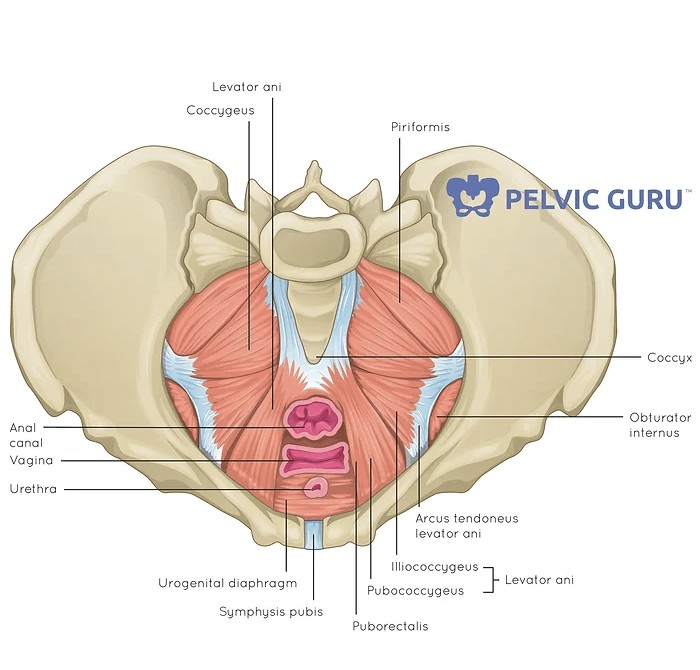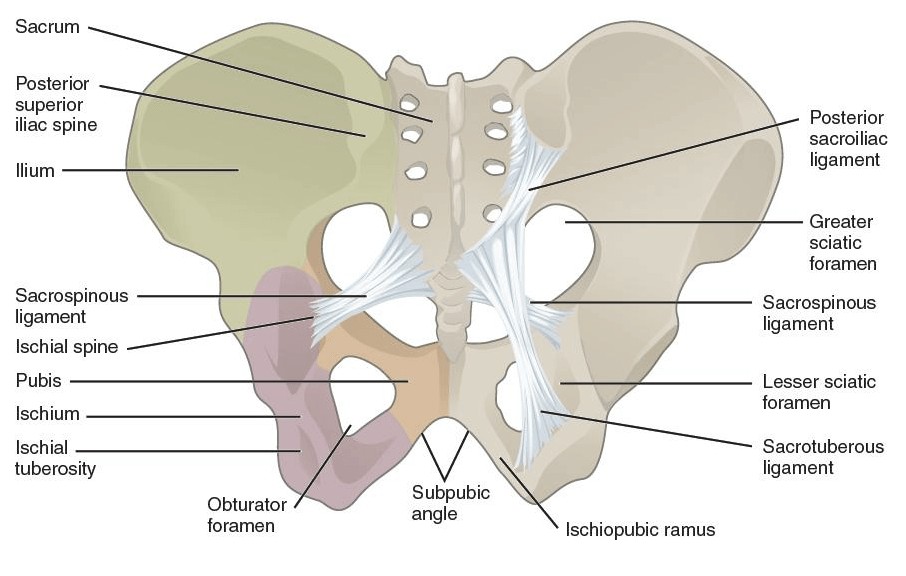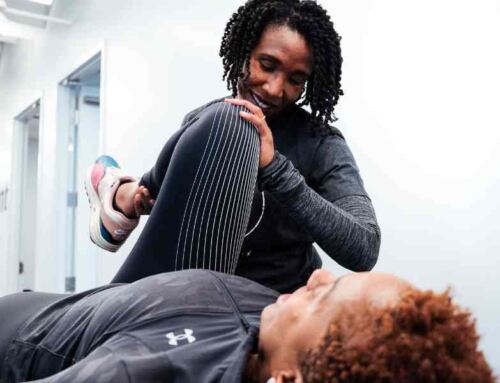6 Tips to Fix Tailbone Pain
Does your tailbone hurt when you’re sitting at your desk? When you’re riding in the car? Maybe you’ve had a direct fall onto your bottom, you went through childbirth, or the pain has seemingly come out of nowhere. Whatever the cause, we can help!
The medical term for tailbone pain is coccydynia. Your coccyx is the very last segment of your spine and is made up of 3-5 vertebrae. Occurrence is 5 times more likely in women than in men. Common causes include pregnancy/childbirth, prolonged sitting, pelvic floor dysfunction, weight gain or loss, repeated strain, and falling.
Know Your Anatomy

Superior view of the female pelvis (looking down into the pelvis).

Posterior view of the pelvis (view from behind)
When someone suffers from tailbone pain, it may not actually be coming from the tailbone. This is why a general understanding of your anatomy can help!
The coccyx is bordered by various muscles, tendons, ligaments, and fascia. It serves as the attachment point for the gluteus maximus, coccygeus, sphincter ani, and levator ani (puborectalis, pubococcygeus, iliococcygeus).
Ligament attachments include: sacrococcygeal, anococcygeal, sacrotuberous, and sacrospinous. These ligaments and muscles help support the pelvic floor and contribute to urinary and bowel control.
Self-Mobilization
These structures around your tailbone may become tight or develop trigger points resulting in dysfunction from pulling on your tailbone.
Self-mobilization with a tennis ball or foam roller may help to relax and lengthen the muscles surrounding the coccyx.
Do not place the tennis ball directly on your tailbone.
To perform self mobilization, place the tennis ball on the muscles between your tailbone (coccyx) and your sit bone (ischial tuberosity).
Once placed, relax into the ball by taking 5 deep breaths (4 count inhale + 4 count exhale) and think of relaxing your pelvic floor. Repeat on the other side.

Stretching
Greater mobility will help reduce pulling on the coccyx due to tightness in the structures surrounding the tailbone. Try these stretches out!
Upward Facing Dog
This pose involves extension of the entire spine, including the tailbone. Increased spinal flexibility can help relieve tension and discomfort.
- Begin by lying face down with your hands placed on the floor by your shoulders.
- Lift your chest by pressing your hands into the floor while keeping your core engaged and your thighs active.
- Roll your shoulders back and down.
- Avoid collapsing into your lower back and discontinue if pain occurs.
- Perform 8-10 repetitions, holding each rep for 2-3 breaths.
Here’s what an upward facing dog looks like.

Child’s Pose (with Hips Internally Rotated)
- Begin in a tabletop position with your knees slightly closer together than your heels.
- Send your hips back towards your heels while extending your arms forward.
- Hold this position for 3-5 breaths then return to tabletop pose.
- Repeat 10 times.
Here’s what a child’s pose looks like.

Glute & Piriformis Stretch
- Begin lying on your back with both feet flat on the floor.
- Cross your left ankle over your right knee.
- Pull your right thigh towards your chest.
- Hold this stretch for 60-90 seconds.
- Repeat on the other side.
Here’s what a glute and piriformis stretch looks like.

How to Choose Hot vs. Cold
Ice:
- When: The first 48-72 hours during the acute phase of pain
- Benefit: Reduces inflammation, numbs the area, alleviates pain
- Application: 15-20 minutes at a time; ensure cloth is between the ice and the skin
Heat:
- When: Chronic pain, especially if there is muscle tension
- Benefit: Increases blood flow, relaxes muscles, and soothes the area
- Application: Use a heating pad or take a warm bath. Ensure the temperature is not too hot to avoid burns
Posture
Sitting: With prolonged sitting becoming the norm for many of us, it’s easy to fall into a slouched posture. This results in a tucked pelvis which can create undue stress on the tailbone and cause pain over time. If you find yourself in this slouched posture, take these steps:
- Place a pillow or towel roll behind your low back.
- Ensure your back rest is at least shoulder height so you can rest your upper back into your chair.
- Adjust your working space so you are not constantly having to look down.
For additional support, when the tailbone pain is unbearable while sitting, there are various cushions with tailbone cut-outs for greater relief. Another option includes rolling up two towels and placing one under each sit bone to offload your tailbone.
Bottom-clenching: This is a common posture that contributes to tailbone pain that most of us don’t even realize we’re doing! This also forces your pelvis to tuck under creating greater flexion and dysfunction of the coccyx. The primary solution for habitual gluteal muscle clenching is learning to relax and bring awareness to your posture.
Find a Pelvic Floor Physical Therapist
As you can see, the area around your tailbone is very complex and may require a full evaluation from a pelvic floor physical therapist to determine the root cause. These professionals have received extensive training to understand all factors that may be contributing to your pain.
How do you know if you have found a high-quality pelvic floor physical therapist? Not only will they assess the region around your coccyx, but they will also assess your posture, breathing mechanics, spinal mobility, ergonomics, gait, and more.
It is so important to look at the whole person because we are all unique and there is no one size fits all treatment.
Contact a MovementX pelvic floor physical therapist today for an in-person or online evaluation so we can help you get the care you need! Or visit www.pelvicrehab.com to find a PT in your area.
References
- UT Southwestern Medical Center. Tailbone Pain During Pregnancy. Available at: https://utswmed.org/medblog/tailbone-pain-during-pregnancy/. Accessed August 26, 2024.
- Mabrouk A, Alloush A, Foye P. Coccyx Pain. In: StatPearls [Internet]. Treasure Island (FL): StatPearls Publishing; 2024 Jan-. Available at: https://www.ncbi.nlm.nih.gov/books/NBK563139/. Updated May 1, 2023. Accessed August 26, 2024.
- Lirette LS, Chaiban G, Tolba R, Eissa H. Coccydynia: an overview of the anatomy, etiology, and treatment of coccyx pain. Ochsner J. 2014;14(1):84-87. PMID: 24688338; PMCID: PMC3963058.
- Mohanty PP, Pattnaik M. Effect of stretching of piriformis and iliopsoas in coccydynia. J Bodyw Mov Ther. 2017;21(3):743-746. doi:10.1016/j.jbmt.2017.03.024.
- Neville CE, et al. Association of coccygodynia with pelvic floor symptoms in women with pelvic pain. PM&R. 2021. Available at: https://onlinelibrary.wiley.com/doi/abs/10.1002/pmrj.12706. Accessed August 26, 2024.
- Coccygodynia (Coccydynia, Coccalgia, Tailbone Pain). Physio-Pedia. Available at: https://www.physio-pedia.com/Coccygodynia_(Coccydynia,_Coccalgia,_Tailbone_Pain). Accessed August 26, 2024.







